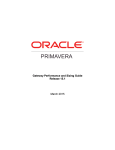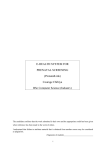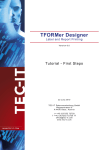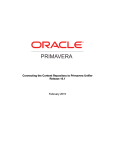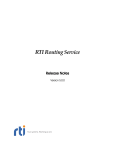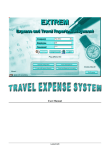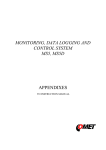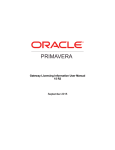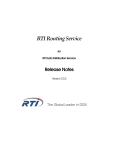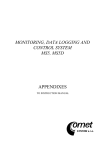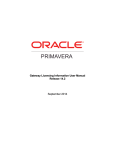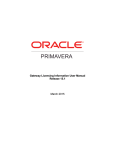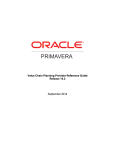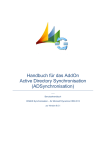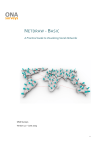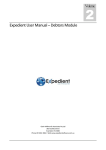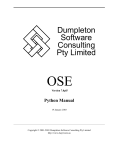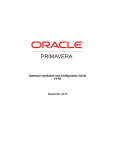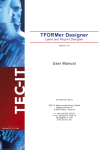Download Gateway Customization Guide
Transcript
Gateway Customization Guide
Release 15.1
March 2015
Contents
Customization Overview ............................................................................. 5
Primavera Gateway Architecture .................................................................. 5
What can be Customized? ........................................................................... 6
Where are the Customizations Stored? ............................................................ 6
Final Customization Artifacts ....................................................................... 6
Customizing an Integration .......................................................................... 7
Setting Up Your Environment ....................................................................... 7
Implementing the Customization Interfaces and Building Your Project ...................... 8
Defining Additional Fields ....................................................................... 8
Direct Field Mapping ............................................................................. 9
Foreign Key Mapping ........................................................................... 10
Custom Java Field Mapping.................................................................... 11
Custom Groovy Field Mapping................................................................. 11
Adding Flow Parameters ....................................................................... 13
Adding Custom Steps ........................................................................... 14
Creating the Customization.XML File ............................................................ 15
Deploying a Customization ........................................................................ 15
Uploading Customization Files Using the Configuration Utility .......................... 15
Supporting Java Customization on a Managed Server ................................. 16
Restarting the WebLogic Domain ................................................................ 17
Appendix - Contents of Customization.XML ..................................................... 19
Customization XML File ............................................................................ 19
For More Information ................................................................................ 39
Where to Get Documentation .................................................................... 39
Where to Get Training ............................................................................. 42
Where to Get Support ............................................................................. 43
Documentation Accessibility ...................................................................... 44
Legal Notices .......................................................................................... 45
3
Customization Overview
Primavera Gateway is an application that facilitates sharing project, resource, and other data
between your enterprise application and Primavera applications, enabling you to combine Oracle
Primavera's management and scheduling power for projects, portfolios, and resources with other
enterprise software.
The Gateway Customization Guide describes how to customize an integration using a provider
that has been created for Primavera Gateway. Also see the Provider's Reference Guide for a list
of business objects supported by each Primavera provider in the data dictionary.
Primavera Gateway Architecture
Primavera Gateway is a web application that is deployed on a WebLogic application server. The
following components are required to load data into a Primavera application and the Gateway
database:
Seed Data, XML files that provide flows and other data that illustrate best practices, which
can be used as a starting point for your implementation.
Primavera Gateway Framework, which includes:
Primavera Gateway user interface
The following providers to support integrations with Primavera applications:
P6 provider
The P6 provider enables you to share data with P6 EPPM. Primavera Gateway supports P6 EPPM
integration with the Oracle Primavera Prime application and a Sample provider.
Prime provider
The Prime provider enables you to share data with the Oracle Primavera Prime application. Primavera
Gateway supports Oracle Primavera Prime integration with the P6 EPPM application.
EnterpriseTrack provider
The EnterpriseTrack provider enables you to share data with Oracle Instantis EnterpriseTrack
application. Primavera Gateway supports Oracle Instantis EnterpriseTrack integration with a Sample
provider.
Unifier provider
The Unifier provider enables you to share data with the Primavera Unifier application. Primavera
Gateway supports Primavera Unifier integration with the P6 EPPM application.
Sample provider
The Sample provider is a provider for demonstration purposes only. The purpose of the Sample
provider is to illustrate how to use Primavera Gateway to synchronize data between a Primavera
application and the Sample provider. Primavera Gateway supports a Sample provider integration with
P6 EPPM and Oracle Instantis EnterpriseTrack applications.
5
Gateway Customization Guide
What can be Customized?
With a provider, an integration can be customized for the following:
Additional fields can be defined
Additional direct field mapping templates can be provided
Additional custom steps can be defined
Additional flows and flow parameters can be defined and specified and the Java code can be
extended to use new parameters
Additional custom Java field mappings and java custom steps can be provided
Additional Groovy field mappings can be provided
Additionally, you can include Java code that uses the custom Java field mappings, custom
steps,and custom parameters. You can also use Groovy code for custom field mappings.
As with most application development work, when you customize a provider, you will generally
need to involve people that have various skills and that perform various roles: programmers,
analysts, users, administration, etc.
Where are the Customizations Stored?
Customizations that you make by interacting with Primavera Gateway are stored in an Oracle
database. The following items are stored in the database:
Cross references (Xref), data value mappings (DVM), flows, metadata (data dictionary), and
customizations
Audit information, logs, and intermediate artifacts
Configuration settings
Schedules
Final Customization Artifacts
The following files must be created and deployed with each provider customization:
A customization description XML file
A .jar file containing any Java code to implement the customization interfaces. The jar file is
not needed if the customization does not have any java code.
6
Customizing an Integration
To customize an integration, complete the following steps:
1) Set up your environment.
2) If you have Java code, then implement the customization interfaces and build your project.
3) Create the customization description XML file.
Note: Usually, building the customization interfaces (Step 2) and creating
the customization XML file (Step 3) occurs simultaneously.
4) Deploy your project and customize the Primavera Gateway database schema by any of the
following methods:
Using the Gateway Setup Configuration Utility
Uploading the customization description XML file from the Customization tab in the
Primavera Gateway user interface
5) Restart the WebLogic domain if the customization includes a .jar file.
For more details on each step, see the corresponding section in this guide.
In This Section
Setting Up Your Environment .................................................................................... 7
Implementing the Customization Interfaces and Building Your Project ...................... 8
Creating the Customization.XML File ...................................................................... 15
Deploying a Customization ...................................................................................... 15
Restarting the WebLogic Domain ............................................................................ 17
Setting Up Your Environment
Set up your environment as follows:
1) Create a folder to contain your customization files. This folder is known as the
<project_home> folder.
2) Locate the <Primavera_Gateway_home>\pdi\snapshots folder and copy the pdi.jar file to
an appropriate folder in your <project_home> folder.
3) Put the pdi.jar file in your project's classpath.
7
Gateway Customization Guide
Implementing the Customization Interfaces and Building Your Project
The Entrance to the Java Code
The CustomizationHandler interface
(com.oracle.pgbu.pdi.customization.CustomizationHandler) provides the entry
point into all of the Java code in the customization jar file and therefore must be implemented.
In the sample customization project, the Customization class (under
com.mycompany.primavera.integration.custom package) implements the
CustomizationHandler interface. The Gateway loads this class through reflection, and retrieves
all other feature implementations by querying this class.
The Java class also must be defined in the XML description file. You can find the following at the
top of the customization.xml from the sample customization project.
<JavaClassPath>com.mycompany.primavera.Customization</JavaClassPath>
Defining Additional Fields
You can customize your application by defining additional fields.
The following example, defines two fields: CostCode UDF field, and TotalPlannedCost UDF field.
In P6 EPPM, customers might have fields defined for project, activity, or other objects. They can
define them using codes (project code, resource code or activity code) or user defined fields
(UDF). Similarly, they might have fields defined in their enterprise application as well that carries
the same information as the corresponding fields in P6 EPPM. Hence, they would want these
fields to be integrated when they implement their integration.
To provide support for these fields, you start by defining them in an XML description file and then
reference the fields later in direct field mappings, foreign field mappings, custom Java field
mappings, Groovy mappings, or custom steps. Here is a sample from the customization.xml in
the sample customization project that defines the CostCode UDF field for Activity and the
TotalPlannedCost UDF field for the project on the P6 side. You can define additional fields for the
enterprise application side as well.
8
Customizing an Integration
<CustomMetadata>
<App>
<Name>P6</Name>
<BusinessObject>
<Name>Activity</Name>
<Field category="UDF">
<Description>Cost code UDF Field</Description>
<Name>CostCode</Name>
<Type>String</Type>
<MaxLength>255</MaxLength>
</Field>
</BusinessObject>
<BusinessObject>
<Name>Project</Name>
<Field category="UDF">
<Description>Total planned cost UDF Field</Description>
<Name>TotalPlannedCost</Name>
<Type>Double</Type>
</Field>
</BusinessObject>
</App>
</CustomMetadata>
Direct Field Mapping
A direct field mapping template defines a series of simple one-to-one field mapping for one
object. The integration product that is built on Primavera Gateway should come with a list of direct
field mapping templates already, but you can add more if this becomes necessary. Here is an
example from the customization.xml in the sample customization project that maps the CostCode
field of the Activity business object and the TotalPlannedCost field of the Project business object:
9
Gateway Customization Guide
<FieldMapTemplates>
<App1Name>Sample</App1Name>
<App2Name>P6</App2Name>
<FieldMapTemplate>
<Description>Cost code mapping for activity object</Description>
<App1BusinessObjectName>Operation</App1BusinessObjectName>
<Name>Activity Cost Code Mapping</Name>
<PDIBusinessObjectName>Activity</PDIBusinessObjectName>
<FieldMap>
<App1>SampleCostCode</App1>
<App2>CostCode</App2>
<PDI>CostCode</PDI>
</FieldMap>
</FieldMapTemplate>
<FieldMapTemplate>
<Description>Total planned cost for project object</Description>
<Name>Project Customization Mapping</Name>
<PDIBusinessObjectName>Project</PDIBusinessObjectName>
<FieldMap>
<App1>TotalPlannedCost</App1>
<App2>TotalPlannedCost</App2>
<PDI>TotalPlannedCost</PDI>
</FieldMap>
</FieldMapTemplate>
</FieldMapTemplates>
Foreign Key Mapping
Foreign keys can now be defined and added in the data dictionary of the source and destination
providers, including Gateway. Once defined, the mapping can then be defined in a mapping
template.
<FieldMapTemplates>
<App1Name>Sample</App1Name>
<App2Name>P6</App2Name>
<FieldMapTemplate>
<Description>Demonstrating mapping foreign key in a mapping template</Description>
<App1BusinessObjectName>Operation</App1BusinessObjectName>
<Name>Sample Mapping Template</Name>
<PDIBusinessObjectName>Activity</PDIBusinessObjectName>
<FieldMap>
<App1>SampleWorkOrderElementId</App1>
<App2>SampleWBSObjectId</App2>
<PDI>SampleWBSObjectId</PDI>
</FieldMap>
</FieldMapTemplate>
</FieldMapTemplates>
In the metadata XML file or the customization XML file, mark the field as a foreign key and set the
JoinTo to the name of the object that this field is joining to as in the example below:
10
Customizing an Integration
<Field>
<Description>Sample WBS Object IDs</Description>
<Name>SampleWBSObjectId</Name>
<JoinTo>WBS</JoinTo>
<Type>ForeignKey</Type>
</Field>
Custom Java Field Mapping
When the field mapping is not as simple as one-to-one, you can use a custom Java field mapping
mechanism. Using a custom Java field mapping involves creating a class that implements the
CustomFieldMap interface. When you implement the CustomFieldMap interface, you have
control of the source object and the target object which permits you to write logic that involves
more than one field. The SampleResourceCustomFieldMap class (under
com.mycompany.primavera.integration.custom.java package) is a simple custom Java field
mapping example in the sample customization project that concatenates the ResourceId and
EmployeeName fields of Resource in the Host side and puts the concatenated field into the
Name field of Resource in the PDI side. This class is defined in the customization.xml in the
following section:
<JavaCustomizationMapping>
<App1Name>Sample</App1Name>
<App2Name>P6</App2Name>
<FieldMapping>
<Description>Resource Java Field Mapping</Description>
<App1BusinessObjectName>Resource</App1BusinessObjectName>
<App2BusinessObjectName>Resource</App2BusinessObjectName>
<Name>SampleResourceCustomFieldMap</Name>
<PDIBusinessObjectName>Resource</PDIBusinessObjectName>
<Fields>
<App1>
<Name>EmployeeName</Name>
</App1>
<App2><Name>Name</Name>
</App2>
</Fields>
</FieldMapping>
</JavaCustomizationMapping>
Custom Groovy Field Mapping
Custom Groovy Field Mapping is similar to Custom Java Field Mapping in that they both can
handle more complex logics and allow multiple fields to participate at the same time. Custom
Groovy Field Mapping is easier to use because the Groovy script is embedded in the
customization description XML file, and therefore will not require a separate jar file.
The syntax of Custom Groovy Field Mapping in the customization description XML file is also
similar to Custom Java Field Mapping. The following is an example from Customization.xml in
SampleCustomization project.
11
Gateway Customization Guide
<GroovyFieldMappingTemplates>
<App1Name>Sample</App1Name>
<App2Name>P6</App2Name>
<GroovyFieldMappingTemplate>
<Description>Sample Groovy resource field mapping</Description>
<App1BusinessObjectName>Resource</App1BusinessObjectName>
<App2BusinessObjectName>Resource</App2BusinessObjectName>
<Name>SampleGroovyResourceFieldMap</Name>
<PDIBusinessObjectName>Resource</PDIBusinessObjectName>
<GroovyFieldMapping>
<Direction>GuestToPDI</Direction>
<SourceFields>EmployeeName,SampleDate</SourceFields>
<TargetFields>Name,PDISampleDate</TargetFields>
<RequireAllFields>true</RequireAllFields>
<Script>
<![CDATA[
Name = EmployeeName.toUpperCase();
if (containsField("EmployeeName")) {
{Name} = [EmployeeName].toUpperCase();
}
if (containsField("SampleDate")) {
def cal = new GregorianCalendar();
cal.setTime([SampleDate]);
cal.add(Calendar.DATE, -1);
cal.add(Calendar.HOUR, 2);
{PDISampleDate} = cal.getTime();
}
}
]]>
</Script>
</GroovyFieldMapping>
</GroovyFieldMappingTemplate>
</GroovyFieldMappingTemplates>
1) At the top, declare the two applications involved in the integration.
2) Declare what business object from each side is involved. In this example, it is Resource
object for all 3 sides.
3) Within one Groovy mapping (GroovyFieldMapping tag), specify the following tags:
Direction: The direction of the mapping, it could be App1ToPDI, App2ToPDI, PDIToApp1
or PDIToApp2.
SourceFields: Comma-separated field names from the source object.
TargetFields: Comma-separated field names from the target object.
Script: The script in Groovy code.
RequireAllFields: When set to True, this mapping will be skipped unless all the source
fields are present in the source object.
Within the Groovy script, use brackets to surround a source field, and curly brackets for a target
field as in the following example:
{Name} = [EmployeeName].toUpperCase();
Where EmployeeName is a field from the source object, and Name is a field from the target
object.
12
Customizing an Integration
You can also use the containsField method to test whether a field exists in the source object.
In the above example, the script uses containsField to test whether EmployeeName or
SampleDate fields are there, before it executes the logic. This is important to know so as to
avoid null pointer exceptions.
When the RequireAllFields tag is set to true, the script will only be called when all source
fields are present in the source object; no possibility for null pointer exception there. But when the
RequireAllFields tag is set to false, the script will be executed even when some source fields are
not present in the source object. In the case when a source field is not present in the source
object, for a primitive type field, such as integer, long, double types, the value will be set to default
value 0; for a string type field, it will be set to default value ""; for a date type field, it will be set to
null.
Limitations
For security reasons, the following limitations have been enforced on Groovy capability:
Loops are not allowed.
Closure is not allowed
Class loading or reflection is not allowed
New classes cannot be defined
File system access is not allowed
Network access is not allowed
Classes under java.lang and java.util only can be accessed, but not any other packages.
Writing one or more expressions and calculating one or more target fields from one or more
source fields is allowed.
Adding Flow Parameters
A flow parameter is a mechanism to get user input for the flow. There are some parameters
defined already for each flow. The flow parameter allows you to define additional parameters for
the Java code to consume. Consider the sample parameter, BusinessUnit, in the sample
customization project. BusinessUnit parameter is a custom type parameter which is a much more
powerful parameter that requires an implementation class. The
BusinessUnitParameterExecutorImpl class (under
com.mycompany.primavera.integration.custom.param package) implements the BusinessUnit
parameter.
The BusinessUnit parameter is defined in the Customization.xml file as follows:
13
Gateway Customization Guide
<FlowDefinitionCustomization>
<FlowDefinitionName>Export Project Data</FlowDefinitionName>
...
<Parameter>
<DefaultValue/>
<Description>A sample custom type parameter</Description>
<Name>BusinessUnit</Name>
<Sequence>5</Sequence>
<Title>Business Unit</Title>
<Type>Custom</Type>
</Parameter>
</FlowDefinitionCustomization>
Adding Custom Steps
A custom step is a very powerful tool that enables customers to make big changes to the flow. In
addition to the normal Load/Convert/Save/Compare steps, you can insert a custom step
anywhere after the load step and before the save step. This allows you to change the document
before the document is passed on to the next step.
Note: When you use a custom step, you have to be very careful not to
disrupt other existing flow steps.
In the sample customization project, there is a sample custom step, SummarizePlannedCost, that
does a very simple summarization. It adds up the PlannedCost of all of the
ResourceAssignments in the project and puts it into a new UDF field of the project object. The
new UDF field is the SummarizePlannedCost field. After performing this task, the custom step
removes all ResourceAssignment elements from the document. A simple boolean type
parameter controls whether the custom step is executed or not.
SummarizePlannedCost can be found under the
com.mycompany.primavera.integration.custom.step package and it is defined in the following
section in the customization.xml file:
<FlowDefinitionCustomization>
<FlowDefinitionName>Export Project Data</FlowDefinitionName>
<!-- <DisableCompare>true</DisableCompare> Uncomment this line to disable compare
for this flow type -->
<FlowStep>
<Description>A sample custom step</Description>
<Name>Summarize Planned Cost</Name>
<OwnerAppName>P6</OwnerAppName>
<Sequence>15</Sequence>
<!-- to make sure it is inserted after Load step before the first convert step -->
<Type>Custom</Type>
</FlowStep>
...
</FlowDefinitionCustomization>
Notice that the sequence number that you set here determines when this step will get called. In
this case, this step is inserted right after the P6 Load step.
14
Customizing an Integration
Creating the Customization.XML File
Create a Customization.xml file for each provider application that you intend to customize.
Primavera Gateway ships a sample customization XML file. The sample customization XML file is
located in <Primavera Gateway Home>\sample\samplecustomization\data folder. You can
use this file along with the Customization.xsd schema file as an example to create a
Customization.xml file specific to your deployment.
Deploying a Customization
Deploy a customization using the Gateway Setup Configuration utility to deploy a customization
description XML file and a .jar file. The utility is a desktop application, and needs direct access to
the database. After deploying the customization, you will need to restart the WebLogic domain.
Notes:
When you install the Primavera Gateway, you have the option to
install a sample customization project that contains examples that
demonstrate how each additional feature can be defined. You will find
the XML description file called Customization.xml under the data
folder. Java source code and Groovy code is included as well.
You can configure how the Primavera Gateway synchronizes data by
interacting with the Primavera Gateway user interface. Additionally,
you can create a provider, or customize an existing provider, to
further control how the adapter loads the data. We supply a Sample
provider that you can use to get started.
Uploading Customization Files Using the Configuration Utility
Use this procedure if a customization includes include XML files, jar files, and other files such as
Java customization. If you have installed Gateway on a managed server, see Supporting Java
Customization on a Managed Server (on page 16) for more details.
Note: If a customization does not include any jar files, and uses Groovy
customization, then upload the XML file from the Gateway user interface.
To add or remove customization files in Gateway:
1) Stop the Gateway domain before adding or removing providers or customizations.
2) Ensure the following:
The bin folder of the supported Java JDK is included in the PATH.
If there are other JDK bin folders in the PATH, it should be listed first.
3) Navigate to the <Primavera_Gateway_Home>/pdi/snapshots/dbsetup-dist folder.
4) If you are installing on a non-Microsoft Windows system, type the following command for
execute privileges:
chmod 755 Gateway-Configuration.sh
5) Run the following command:
15
Gateway Customization Guide
For Windows installations, run Gateway-Configuration.bat
For Linux and Solaris installations, run ./Gateway-Configuration.sh
6) In the Primavera Gateway Configuration Utility dialog box, enter the following information:
a. Select Manage Customizations, and select Next.
Selecting this option updates the pdi.ear file and the Gateway database with custom
metadata from the customization XML files.
b. In the Select Gateway ear file (pdi.ear) location, enter or select Browse to locate the
.ear file.
c. In the Installed Gateway Customizations field, review the list of customization files
displayed in the dialog box, and perform any of the following actions:
To add a customization, select Add Customization, and navigate to the folder
location of the customization file.
To remove a customization from the list, select a specific customization, and select
Remove.
To delete a customization from the database and the pdi.ear file, select the Delete
option and select Remove.
7) Enter the following database connection details:
DBA User Name: Enter the name of the database administrator.
DBA Password: Enter the password for the database administrator.
Database Host: Enter the host name of the Oracle database on which you will be
updating the Primavera Gateway database.
Database Host Port: Enter the port number of the Oracle database.
Database Name: Enter the Gateway database name and select any of the following
methods to connect to the database.
SID: Enter the SID of the Oracle database.
Service: Enter the service name of the Oracle database.
Schema Owner: Enter the name of Gateway schema owner. (This name should match
the name that was entered when you installed Primavera Gateway.)
Schema Password: Enter the password for the schema owner.
Select Test Connection. Modify the applicable fields if the connection fails and repeat as
necessary.
Select Update. The status field displays a success message.
Select Finish to exit the configuration utility.
Supporting Java Customization on a Managed Server
If you have installed Gateway on a managed server, complete the following steps to ensure
Java customization is supported:
1)
2)
3)
4)
16
Log in to the WebLogic Administration console for Gateway.
Select pdi.ear in Deployments tab and stop the deployment.
Select Lock & Edit in the left pane and select pdi.ear in Deployments tab.
Select Update to update pdi.ear for the managed server.
Customizing an Integration
5) Save the changes from the left pane (Activate Changes)
6) Restart pdi.ear deployment.
Restarting the WebLogic Domain
Finally, complete the customizations by restarting the WebLogic domain. Depending on your
operating system, proceed as follows to restart the Primavera Gateway domain.
Note: Oracle recommends that you use the
<PrimaveraGateway_home>\WLST\startGatewayWLDomain.* scripts to
stop and start the Primavera Gateway domain because these scripts
contain the specific memory and timezone settings required by Primavera
Gateway.
1) First stop the WebLogic domain.
For Windows, from the Start menu, point to Oracle - Primavera Gateway and select Stop
Primavera Gateway.
This invokes the stopGatewayWLDomain.cmd file.
For Linux and Solaris, enter cd <Primavara Gateway_Home>/WLST, and then run the
following script:
./stopGatewayWLDomain.sh
Note: If you are using a non Windows system, you may need to set
permissions on the stopGatewayWLDomain.sh file. If so enter the
following command: chmod 755 stopGatewayWLDomain.sh.
2) Start the WebLogic domain.
For Windows: From the Start menu, point to Oracle - Primavera Gateway and select Start
Primavera Gateway.
This invokes the startGatewayWLDomain.cmd file.
For Linux and Solaris, enter cd <Primavara Gateway_Home>/WLST, and then run the
following script:
./startGatewayWLDomain.sh
17
Appendix - Contents of Customization.XML
In This Section
Customization XML File........................................................................................... 19
Customization XML File
This file is loaded into the system by the data loader utility and is used to extend the system by
adding any of the following customizations to the Source application, Gateway or the destination
application:
User-defined fields (UDFs)
Mapping templates
Java custom mappings
Java custom steps
Custom parameters
Groovy field mappings
Foreign field mappings
Flow Definition customizations
Custom metadata
Custom XRefs
Schema File
Customization.xsd
Contents
A Customization element containing the following elements:
Element
Type
Parents
Description
Name
string
restricted to
maxLength(60)
Customization
The optional element
that specifies the name
of the customization.
Version
string
restricted to
maxLength(60)
Customization
The optional element
that specifies the version
of the customization.
19
Gateway Customization Guide
Element
JavaClassPath
CustomMetadata
CustomXRef
Type
Parents
Description
Customization
The optional element
that specifies the path to
the customization file
that loads the
customization functions.
This element is required
if you are using Java
customization.
CustomMetadataTyp
Customization
e
The optional element
that contains zero to
three App elements.
An example use is to add
references to user
defined fields (UDFs).
CustomXRefType
The optional element
that contains zero to
more custom XRef
elements.
string
restricted to
maxLength(255)
Customization
FieldMapTemplatesT
Customization
ype
The optional element
that contains zero to
many FieldMapTemplate
elements that can be
used to map additional
fields.
JavaCustomizationM JavaCustomizationM
Customization
apping
appingType
The zero to many
optional elements that
contain the following
elements:
GuestAppName
(required if the parent
is present).
HostAppName
(required if the parent
is present).
Zero to many
FieldMapping
elements.
GroovyFieldMapping GroovyFieldMapping
Customization
Templates
TemplatesType
The optional element
that contains zero to
manny
GroovyFieldMappingTe
mplate elements.
FieldMapTemplates
20
Appendix - Contents of Customization.XML
Element
FlowDefinitionCusto
mization
Type
FlowDefinitionCusto
mizationType
Parents
Description
Customization
The zero to many
optional elements that
allow you to add custom
parameters to a
particular flow. Contains
the following elements:
FlowDefinitionName
element (required if
the parent is
present).
DisableCompare
boolean flag.
Zero to many
FlowStep elements.
Zero to many
Parameter elements.
Parent
Description
CustomMetadataType Table
Element
Type
App
AppType
The application to which
For more details, see CustomMetada
you are adding a user
the AppType table
ta
defined field (UDF).
below.
CustomXRefType Table
Element
XRefMap
Type
Parent
XRefMapType
For more details, see
CustomXRef
the XRefMapType
table below.
Description
The element that
contains one or more
XRef maps. A XRef map
contains a mapping of
business objects
cross-referenced
between two
applications.
21
Gateway Customization Guide
XRefMapType Table
Element
Type
Parent
Description
App1Name
string
XRefMap
The name of the
application.
App2Name
string
XRefMap
The name of the
application.
XRefObject
XRefObjectType
For more details, see
XRefMap
the XRefObjectType
table below.
One or more XRef
objects in the XRef map.
XRefObjectType Table
Element
Type
Parent
Description
Name
string
XRefObject
The name of the
cross-reference object.
App1Name
string
XRefObject
The App1 business
object name if different
from the Name element.
PDIName
string
XRefObject
The PDI business object
name if different from the
Name element.
App2Name
string
XRefObject
The App2 business
object name if different
from the Name element.
App1PrimaryKeyFiel
string
dName
XRefObject
The name of the primary
key field in the database
of the application.
PDIPrimaryKeyField
string
Name
XRefObject
The name of the primary
key field in the Gateway
database.
App2PrimaryKeyFiel
string
dName
XRefObject
The name of the primary
key field in the database
of the application.
22
Appendix - Contents of Customization.XML
AppType Table
Element
Type
Name
string
restricted to
maxLength(60)
ObjectCategory
ObjectCategoryType App
Provides a mechanism
for classifying objects.
FieldCategoryType
App
Provides a mechanism
for classifying fields. It is
defined here and
referenced by attribute
"category" when a field is
defined within a business
object. For example, in
the P6 provider, "udf" is
defined as a field
category to indicate that
this field is an actual
user-defined field in the
P6 EPPM side.
BusinessObjectType App
The zero to many
business object elements
that are containers for
field elements that relate
to the business object
specified by the Name
element.
All custom UDF fields
defined in this element
will be included when
updating the business
object.
FieldCategory
BusinessObject
Parent
Description
App
The name of the
application to which you
are adding a user-defined
field (UDF).
ObjectCategoryType Table
Element
Type
Parent
Description
Name
string
restricted to
maxLength(60)
ObjectCategor The name of the object
y
category.
23
Gateway Customization Guide
Element
Type
Parent
Description
Description
string
restricted to
maxLength(255)
ObjectCategor The description of the
y
object category.
FieldCategoryType Table
Element
Type
Parent
Description
Name
string
restricted to
maxLength(60)
FieldCategory
The name of the field
category.
Description
string
restricted to
maxLength(255)
FieldCategory
The description of the
field category.
BusinessObjectType Table
Element
Type
Parent
Description
Name
string
restricted to
maxLength(60)
BusinessObje
ct
The name of the
business object to which
you are adding the user
defined field.
FieldType
BusinessObje
ct
All custom UDF fields
defined inside this
element will be included
when updating the
business object.
Type
Parent
Description
Field
The element that
describes the field. This
description is presented
in the Fields table on the
Data Dictionary tab in
the Primavera Gateway
user interface.
Field
FieldType Table
Element
Description
24
string
restricted to
maxLength(255)
Appendix - Contents of Customization.XML
Element
Type
Name
string
restricted to
maxLength(60)
JoinTo
string
restricted to
maxLength(60)
Type
string
restricted to
maxLength(10)
'Boolean'
'DateTime'
'Double'
'Int'
'String'
'ForeignKey'
'Enum'
MaxLength
MaxValue
positiveInteger
double
Parent
Description
Field
The element that
determines the name of
the field. This name is
presented in the Fields
table of the Data
Dictionary tab in the
Primavera Gateway user
interface.
Field
The element that
contains the name of the
object to which it is being
joined to.
Field
The element that defines
the data type of the value
of the field's data when it
is synchronized.
Field
The optional element that
defines the maximum
length of the value of the
field's data when it is
synchronized. This
element can be used with
the Type element whose
content is String to limit
the field's data values.
Field
The optional element that
defines the maximum
value of the field's data
when it is synchronized.
This element can be
used with the Type
element whose content is
Int to limit the field's data
values.
25
Gateway Customization Guide
Element
MinValue
FieldValue
Type
double
FieldValueType
Parent
Description
Field
The optional element that
defines the minimum
value of the field's data
when it is synchronized.
This element can be
used with the Type
element whose content is
Int to limit the field's data
values.
Field
An optional element that
defines the value of an
enum field type.
Field elements can
contain zero or more
FieldValue elements if
the Field element
contains a Type element
whose content is Enum.
FieldValueType Table
Element
Type
Parent
Description
Description
string
restricted to
maxLength(255)
FieldValue
An optional element that
describes the fieldValue.
Value
string
restricted to
maxLength(60)
FieldValue
An optional element that
defines an enumerated
value.
FieldMapTemplatesType Table
Element
Type
Parents
Description
App1Name
string
restricted to
maxLenth(60)
Customization
The name of the
application.
App2Name
string
restricted to
maxLenth(60)
Customization
The name of the
application.
26
Appendix - Contents of Customization.XML
Element
Type
Parents
Description
GuestAppName
string
restricted to
maxLength(60)
Customization
The name of the guest
application.
HostAppName
string
restricted to
maxLength(60)
Customization
The name of the host
application.
FieldMapTemplate
FieldMapTemplateTy
Customization
pe
The container element
that contains zero to
many
FieldMapTemplates
included in the
customization.
FieldMapTemplateType Table
Element
Type
Parents
Description
string
restricted to
maxLength(255)
The text that is used in
the Primavera Gateway
FieldMapTempl
user interface to provide
ate
a description of the field
mapping.
string
App1BusinessObjec
restricted to
tName
maxLength(60)
Description
The Guest business
object name if different
FieldMapTempl
from the
ate
PDIBusinessObjectName
element.
The Host business object
App2BusinessObjec FieldMapTemplateTy FieldMapTempl name if different from the
tName
pe
ate
PDIBusinessObjectName
element.
string
GuestBusinessObje
restricted to
ctName
maxLength(60)
Guest business object
FieldMapTempl name if different from
ate
PDIBusinessObjectName
element.
string
HostBusinessObject
restricted to
Name
maxLength(60)
Host business object
FieldMapTempl name if different from
ate
PDIBusinessObjectName
element.
27
Gateway Customization Guide
Element
Type
Parents
Description
Name
string
restricted to
maxLength(60)
The text that is used in
the Primavera Gateway
FieldMapTempl
user interface to provide
ate
a name for the field
mapping.
PDIBusinessObject
Name
string
restricted to
maxLength(60)
The PDI business object
name. Also indicates the
guest and\or the host
business object name if
FieldMapTempl
the
ate
GuestBusinessObjectNa
me or the
HostBusinessObjectNam
e elements are omitted.
FieldMap
FieldMapType
FieldMapTempl The element that
ate
specifies the field map.
Element
Type
Parents
Description
App1
string
restricted to
maxLength(60)
FieldMap
The name of the
application.
App2
string
restricted to
maxLength(60)
FieldMap
The name of the
application.
FieldMap
The element that
specifies the name of the
field that is involved in the
mapping from the
provider side of the
mapping.
FieldMap
The element that
specifies the name of the
field that is involved in the
mapping from the
Primavera provider side
of the mapping.
FieldMapType Table
Guest
Host
28
string
restricted to
maxLength(60)
string
restricted to
maxLength(60)
Appendix - Contents of Customization.XML
Element
Type
PDI
string
restricted to
maxLength(60)
Parents
Description
FieldMap
The element that
specifies the name of the
field that is involved in the
mapping from the
Gateway side.
Description
JavaCustomizationMappingType Table
Element
Type
Parents
App1Name
string
restricted to
maxLength(60)
JavaCustomiza The name of the
tionMapping
application.
App2Name
string
restricted to
maxLength(60)
JavaCustomiza The name of the
tionMapping
application.
GuestAppName
string
restricted to
maxLength(60)
The name of the
JavaCustomiza application in the
tionMapping
apptable in the Gateway
database.
HostAppName
string
restricted to
maxLength(60)
The name of the
JavaCustomiza Primavera application in
tionMapping
the apptable in the
Gateway database.
FieldMapping
FieldMappingType
The element that
JavaCustomiza
specifies the field
tionMapping
mapping.
GroovyFieldMappingTemplatesType Table
Element
Type
Parents
Description
App1Name
string
restricted to
maxLength(60)
JavaCustomiza The name of the
tionMapping
application.
App2Name
string
restricted to
maxLength(60)
JavaCustomiza The name of the
tionMapping
application.
29
Gateway Customization Guide
Element
Type
Parents
Description
GuestAppName
string
restricted to
maxLength(60)
The name of the
GroovyFieldMa application designated as
ppingTemplate Guest application in the
s
apptable in the Gateway
database.
HostAppName
string
restricted to
maxLength(60)
The name of the
GroovyFieldMa application designated as
ppingTemplate the Host application in
s
the apptable in the
Gateway database.
The name of the
GroovyFieldMa GroovyFieldMappingTem
GroovyFieldMapping GroovyFieldMapping
ppingTemplate plate associated with the
Template
TemplateType
s
applications designated
as Guest and Host.
GroovyFieldMappingTemplateType Table
Element
Description
Type
Parents
Description
string
restricted to
maxLength(255)
The name of the
GroovyFieldMa application designated as
ppingTemplate Guest application in the
s
apptable in the Gateway
database.
string
App1BusinessObject
restricted to
Name
maxLength(60)
GroovyFieldMa The name of the
ppingTemplate business object in the
s
application.
string
App2BusinessObject
restricted to
Name
maxLength(60)
GroovyFieldMa The name of the
ppingTemplate business object in the
s
application.
string
GuestBusinessObjec
restricted to
tName
maxLength(60)
The Guest business
GroovyFieldMa object name if it is
ppingTemplate different from the
s
PDIBusinessObjectName
element.
string
HostBusinessObject
restricted to
Name
maxLength(60)
The Host business object
GroovyFieldMa name if it is different from
ppingTemplate the
s
PDIBusinessObjectName
element.
30
Appendix - Contents of Customization.XML
Element
Type
Parents
Name
string
restricted to
maxLength(255)
GroovyFieldMa
The name of the Groovy
ppingTemplate
business object.
s
string
PDIBusinessObjectN
restricted to
ame
maxLength(60)
Description
The name of the
GroovyFieldMa
PDIBusinessObjectName
ppingTemplate
in the Gateway data
s
dictionary.
The GroovyFieldMapping
being associated with the
GuestBusinessObjectNa
GroovyFieldMa
GroovyFieldMapping
me,
GroovyFieldMapping
ppingTemplate
Type
HostBusinessObjectNam
s
e, and
PDIBusinessObjectName
.
GroovyFieldMappingType Table
Element
Type
Parents
Description
Direction
string
restricted to
maxLength(10)
'GuestToPDI'
'HostToPDI'
'PDIToGuest'
'PDIToHost'
'App1ToPDI'
'App2ToPDI'
'PDIToApp1'
'PDIToApp2'
The direction of the data
flow between the source
GroovyFieldMa
application and
pping
destination application in
the GroovyFieldMapping.
SourceFields
string
The fields in the source
GroovyFieldMa
application referenced in
pping
the GroovyFieldMapping.
TargetFields
string
The fields in the target
GroovyFieldMa
application referenced in
pping
the GroovyFieldMapping.
RequireAllFields
boolean
The flag to determine if
GroovyFieldMa
all fields are required for
pping
the GroovyFieldMapping.
31
Gateway Customization Guide
Element
Type
Parents
Description
Script
string
restricted to
maxLength(1024)
The element that
GroovyFieldMa
contains the Groovy
pping
code.
FieldMappingType Table
Element
Type
Parents
Description
Description
string
restricted to
maxLength(255)
FieldMapping
The description of the
custom java field map.
FieldMapping
The name of the
business object in the
application.
FieldMapping
The name of the
business object in the
application.
FieldMapping
The Guest business
object name if different
from
PDIBusinessObjectName
element.
FieldMapping
The Host business object
name if different from
PDIBusinessObjectName
element.
FieldMapping
The name name of the
field map that is used to
look up the Java class in
the code that you have
written that contains
customization logic.
FieldMapping
The Gateway business
object name in the field
mapping.
FieldMapping
The container element for
the fields defined inside
this element to be
included when loading
the business object.
string
App1BusinessObject
restricted to
Name
maxLength(60)
string
App2BusinessObject
restricted to
Name
maxLength(60)
string
GuestBusinessObjec
restricted to
tName
maxLength(60)
string
HostBusinessObject
restricted to
Name
maxLength(60)
Name
string
restricted to
maxLength(255)
string
PDIBusinessObjectN
restricted to
ame
maxLength(60)
Fields
32
FieldsType
Appendix - Contents of Customization.XML
FieldsType Table
Element
Type
Parents
Description
App1
FieldsFieldType
Fields
The name of the
application.
App2
FieldsFieldType
Fields
The name of the
application.
Fields
The element that
specifies the name of the
fields in the mapping
from the application
designated as the Guest
application.
Fields
The element that
specifies the name of the
fields in the mapping
from the Primavera
application designated as
the Host application.
Fields
The element that
specifies the name of the
fields that is involved in
the mapping from the
Gateway side.
Parents
Description
string
FlowDefinitionName restricted to
maxLength(60)
FlowDefinition
Customization
The name of the flow to
which the parameters are
to apply.
string
restricted to
maxLength(60)
FlowDefinition
Customization
The name of the
application to which the
customization applies.
boolean
FlowDefinition
Customization
The flag when set to true,
causes compare to be
disabled for all
FlowTypes.
Guest
Host
PDI
FieldsFieldType
FieldsFieldType
FieldsFieldType
FlowDefinitionCustomizationType Table
Element
Application Name
DisableCompare
Type
33
Gateway Customization Guide
Element
Type
Parents
Description
AppType
string
restricted to
maxLength(10)
'Guest'
'Host'
'PDI'
FlowDefinition
Customization
The role of the application
in the flow.
FlowStepType
FlowDefinition
Customization
The element that contains
flow steps that define an
end-to-end
synchronization.
ParameterType
FlowDefinition
Customization
The element that
specifies the properties of
the parameter.
Element
Type
Parents
Description
Description
string
restricted to
maxLength(255)
FlowStep
The element that
describes the purpose of
the flow step.
Name
string
restricted to
maxLength(60)
FlowStep
The element that
determines the name of
the flow step.
FlowStep
The element that the
system uses to determine
which document format to
use when parsing XML
document data.
For example, specifying
the OwnerAppType as
Host and P6 is the host of
the flow causes the
system to ask the P6
provider to provide the
implementation of this
step.
FlowStep
Parameter
FlowStepType Table
OwnerAppType
34
string
restricted to
maxLength(10)
'Guest'
'Host'
'PDI'
Appendix - Contents of Customization.XML
Element
Sequence
Type
int
Parents
FlowStep
Description
A number that determines
when the step will run
relative to the other steps
in the flow.
When this element is
used in a
customization.xml file,
you can use the following
SQL commands to
determine the existing
sequencing, from which
you can determine an
appropriate sequence
number for a particular
flow type.
Note: This example
returns the sequence
number for the Export
Project Data flow type.
Revise the commands as
appropriate for the other
flow types.
select fd.flowdef_name,
fs.flowstep_name,
fs.flowstep_type,
fs.flowstep_seqno
from flowstep fs, flowdef fd
where fs.flowdef_id =
fd.flowdef_id and
fd.flowdef_name = 'Export
Project Data'
order by fd.flowdef_name,
fs.flowstep_seqno;
Type
string
restricted to
maxLength(20)
'Custom'
FlowStep
The element that
specifies the flow step
type. 'Custom' is the
only valid value when this
element is used in a
customization.xml file.
35
Gateway Customization Guide
ParameterType Table
Element
Type
Parents
Description
DefaultValue
string
restricted to
maxLength(255)
Parameter
The default value for this
custom parameter that is
used when the parameter
is included in the flow and
the value is not changed.
Description
string
restricted to
maxLength(255)
Parameter
The element that provides
a description of the
parameter.
EnumerationOption
sType
For more details see
EnumerationOptions
Parameter
the
EnumerationOption
sType Table.
The element that contains
the list of enumerated
values when the
Parameter element is
specified as an enum.
Name
string
restricted to
maxLength(60)
Parameter
The element that provides
the name of the
parameter. The name is
used to lookup the
parameter in the provider
Java code.
Sequence
int
Parameter
The element that provides
the mechanism for
ordering the parameters.
Title
string
restricted to
maxLength(255)
Parameter
The element that provides
the display title of the
parameter.
Type
string
restricted to
maxLength(15)
Boolean
DateTime
Double
Int
String
Password
Enum
Custom
Parameter
The element that defines
the data type of the value
of the field's data when it
is synchronized.
36
Appendix - Contents of Customization.XML
EnumerationOptionsType Table
Element
Type
Parents
Description
Enumeration
EnumerationType
The element that specifies
EnumerationOp
the name of the
tions
enumeration.
FieldsFieldType Table
Element
Type
Parents
Description
Name
string
restricted to
maxLength(60)
Fields
The element that specifies
the name of the field.
EnumerationType Table
Element
Type
Parents
Description
Name
string
restricted to
maxLength(60)
Fields
The element that specifies
the name of the
enumeration type.
37
For More Information
In This Section
Where to Get Documentation .................................................................................. 39
Where to Get Training ............................................................................................. 42
Where to Get Support ............................................................................................. 43
Documentation Accessibility .................................................................................... 44
Where to Get Documentation
Complete documentation libraries for Primavera Gateway releases are available on the Oracle
Technology Network (OTN) at:
http://www.oracle.com/technetwork/documentation/default-1923957.html
From this location you can either view libraries online or download them to have local copies. We
recommend viewing them from OTN to ensure you always access the latest versions, including
critical corrections and enhancements.
Primavera Gateway is configured to access its help system on OTN. However, you can also
install a local version when you install the software.
The documentation assumes a standard setup of the product, with full access rights to all
features and functions.
The following table describes the core documents available for Primavera Gateway and lists the
recommended readers by role.
Title
Description
Gateway Help
Describes how to work with Primavera Gateway and
provides information to help users accomplish tasks.
All users should read the Help.
Gateway Developer's
Guide
Provides information on how third-party systems such as
enterprise resource management (ERP) and enterprise asset
management (EAM) systems can create their own providers
in order to integrate with Primavera products.
Developers of third-party providers that integrate with
Primavera products via Primavera Gateway should read this
book.
39
Gateway Customization Guide
Title
Description
Gateway Customization
Guide
Provides information on how to customize an existing
third-party integration.
Developers interested in customizing existing third-party
providers that integrate with Primavera products via
Primavera Gateway should read this book.
Gateway Provider
Reference Guide
Provides a list of the business objects available for each
supported provider.
Developers of third-party providers that integrate with
Primavera products via Primavera Gateway should read this
book.
EBS Provider Reference Provides a list of the business objects available for the EBS
Guide
provider.
Developers of third-party providers that integrate with
Primavera products via Primavera Gateway should read this
book.
VCP Provider Reference Provides a list of the business objects available for the VCP
Guide
provider.
Developers of third-party providers that integrate with
Primavera products via Primavera Gateway should read this
book.
Manual Deployment
Guide
Provides information on how to manually install and
configure Primavera Gateway.
The Primavera Gateway network administrator/database
administrator and the administrator for the third-party or ERP
system should read this guide.
Gateway Installation and Provides information on how to install and configure
Configuration Guide
Primavera Gateway. Primavera Gateway is a product that
facilitates integrations with Primavera products and
third-party systems such as enterprise resource
management (ERP) and enterprise asset management
(EAM) systems.
The Primavera Gateway network administrator/database
administrator and the administrator for the third-party or ERP
system should read this guide.
Gateway Upgrade Guide Provides a sequence of procedures that must be completed
to upgrade to a new version of Primavera Gateway.
The Primavera Gateway network administrator/database
administrator and the administrator for the third-party or ERP
system should read this guide.
40
For More Information
Title
Description
Gateway Performance
and Sizing Guide
Provides hardware and software requirements for deploying
Primavera Gateway.
The Primavera Gateway network administrator/database
administrator and the administrator for the third-party or ERP
system should read this guide.
Gateway Security Guide Provides guidelines on establishing a highly secure
environment for all Primavera Gateway environments.
The Primavera Gateway network administrator/database
administrator and the administrator for the third-party or ERP
system should read this guide.
Gateway API
Programmer's Guide
Provides instructions on how to access and use Primavera
Gateway REST APIs.
The Primavera Gateway network administrator/database
administrator and Primavera Gateway users having the
Gateway Developer role should read this guide.
Connecting with Instantis Provides instructions on how to setup the integration
EnterpriseTrack
environment for Oracle Instantis EnterpriseTrack in
Primavera Gateway.
The Primavera Gateway network administrator/database
administrator and the administrator for the third-party system
should read this guide.
Connecting Prime and
P6 EPPM
Provides instructions on how to setup the integration
environment between Oracle Primavera Prime and P6
Enterprise Project Portfolio Management in Primavera
Gateway.
The Primavera Gateway network administrator/database
administrator and the administrator for the third-party system
should read this guide.
Connecting Unifier and
P6 EPPM
Provides instructions on how to setup the integration
environment between Oracle Primavera Unifier and P6
Enterprise Project Portfolio Management in Primavera
Gateway.
The Primavera Gateway network administrator/database
administrator and the administrator for the third-party system
should read this guide.
Migrating P6 Data
Between Distinct
Environments
Provides instructions on how to setup the integration
environment between distinct P6 deployments to transfer P6
data in Primavera Gateway.
The Primavera Gateway network administrator/database
administrator and the administrator should read this guide.
41
Gateway Customization Guide
Title
Description
Connecting E-Business
Suite
Provides instructions on how to setup the integration
environments for Oracle E-Business Suite with P6 Enterprise
Project Portfolio Management and Instantis EnterpriseTrack
in Primavera Gateway.
The Primavera Gateway network administrator/database
administrator and the administrator for the third-party system
should read this guide.
Connecting Value Chain Provides instructions on how to setup the integration
Planning and P6 EPPM environment between Oracle Value Chain Planning and P6
Enterprise Project Portfolio Management in Primavera
Gateway.
The Primavera Gateway network administrator/database
administrator and the administrator for the third-party system
should read this guide.
Configuring Gateway for Provides instructions on how to configure Oracle Access
Single Sign On
Manager (OAM) and then enable Single Sign On for
Primavera Gateway.
The Primavera Gateway network administrator/database
administrator should read this guide.
Gateway Licensing
Lists licensing information of all third-party software that is
Information User Manual used or associated with the Oracle software program.
Tested Configurations
Lists the configurations that have been tested and verified to
work with Primavera Gateway.
The Primavera Gateway network administrator/database
administrator and the administrator for the third-party or ERP
system should read this guide.
Distributing Information to the Team
You can copy the online documentation to a network drive for access by project participants.
Each team member can then view or print those portions that specifically relate to his or her role
in the organization.
Throughout this documentation, the Security Guidance icon
helps you to quickly identify
security-related content to consider during the installation and configuration process.
Where to Get Training
To access comprehensive training for all Primavera products, go to:
http://education.oracle.com
42
For More Information
Oracle Learning Library
The Oracle Learning Library (OLL) provides online learning content covering Primavera products.
Content includes videos, tutorials, articles, demos, step-by-step instructions to accomplish
specific tasks, and self-paced interactive learning modules.
To access the learning library’s Primavera content, go to:
http://www.oracle.com/goto/oll
Where to Get Support
If you have a question about using Oracle products that you or your network administrator cannot
resolve with information in the documentation or help, click http://support.oracle.com/. This page
provides the latest information on contacting Oracle Global Customer Support, knowledge
articles, and the support renewals process. For more information about working with Support,
visit https://support.oracle.com/epmos/faces/DocumentDisplay?id=888813.2 to view Support
Tools & Tips.
Access to Oracle Support
Oracle customers have access to electronic support through My Oracle Support. For information,
visit http://www.oracle.com/us/support/contact-068555.html or visit
http://www.oracle.com/us/corporate/accessibility/support/index.html if you are hearing impaired.
Using Primavera's Support Resource Centers
Primavera’s Support Resource Center provides links to important support and product
information. Primavera's Product Information Centers (PICs) organize documents found on My
Oracle Support (MOS), providing quick access to product and version specific information such
as important knowledge documents, Release Value Propositions, and Oracle University training.
PICs also offer documentation on Lifetime Management, from planning to installs, upgrades, and
maintenance.
Visit https://support.oracle.com/epmos/faces/DocumentDisplay?id=1486951.1 to access links to
all of the current PICs.
PICs also provide access to:
Communities are moderated by Oracle providing a place for collaboration among industry
peers to share best practices.
News from our development and strategy groups.
Education contains a list of available Primavera product trainings through Oracle
University. The Oracle Advisor Webcast program brings interactive expertise straight to the
desktop using Oracle Web Conferencing technology. This capability brings you and Oracle
experts together to access information about support services, products, technologies, best
practices, and more.
For more information about working with Support, visit
https://support.oracle.com/epmos/faces/DocumentDisplay?id=888813.2.
43
Gateway Customization Guide
Documentation Accessibility
For information about Oracle's commitment to accessibility, visit the Oracle Accessibility Program
website at http://www.oracle.com/pls/topic/lookup?ctx=acc&id=docacc.
44
Legal Notices
Oracle Primavera Gateway Customization Guide
Copyright © 2013, 2015, Oracle and/or its affiliates. All rights reserved.
Oracle and Java are registered trademarks of Oracle and/or its affiliates. Other names may be
trademarks of their respective owners.
This software and related documentation are provided under a license agreement containing
restrictions on use and disclosure and are protected by intellectual property laws. Except as
expressly permitted in your license agreement or allowed by law, you may not use, copy,
reproduce, translate, broadcast, modify, license, transmit, distribute, exhibit, perform, publish or
display any part, in any form, or by any means. Reverse engineering, disassembly, or
decompilation of this software, unless required by law for interoperability, is prohibited.
The information contained herein is subject to change without notice and is not warranted to be
error-free. If you find any errors, please report them to us in writing.
If this is software or related documentation that is delivered to the U.S. Government or anyone
licensing it on behalf of the U.S. Government, the following notice is applicable:
U.S. GOVERNMENT END USERS: Oracle programs, including any operating system, integrated
software, any programs installed on the hardware, and/or documentation, delivered to U.S.
Government end users are “commercial computer software" pursuant to the applicable Federal
Acquisition Regulation and agency-specific supplemental regulations. As such, use, duplication,
disclosure, modification, and adaptation of the programs, including any operating system,
integrated software, any programs installed on the hardware, and/or documentation, shall be
subject to license terms and license restrictions applicable to the programs. No other rights are
granted to the U.S. Government.
This software or hardware is developed for general use in a variety of information management
applications. It is not developed or intended for use in any inherently dangerous applications,
including applications that may create a risk of personal injury. If you use this software or
hardware in dangerous applications, then you shall be responsible to take all appropriate failsafe,
backup, redundancy, and other measures to ensure its safe use. Oracle Corporation and its
affiliates disclaim any liability for any damages caused by use of this software or hardware in
dangerous applications.
This software or hardware and documentation may provide access to or information on content,
products and services from third-parties. Oracle Corporation and its affiliates are not responsible
for and expressly disclaim all warranties of any kind with respect to third-party content, products,
and services. Oracle Corporation and its affiliates will not be responsible for any loss, costs, or
damages incurred due to your access to or use of third-party content, products, or services.
45













































